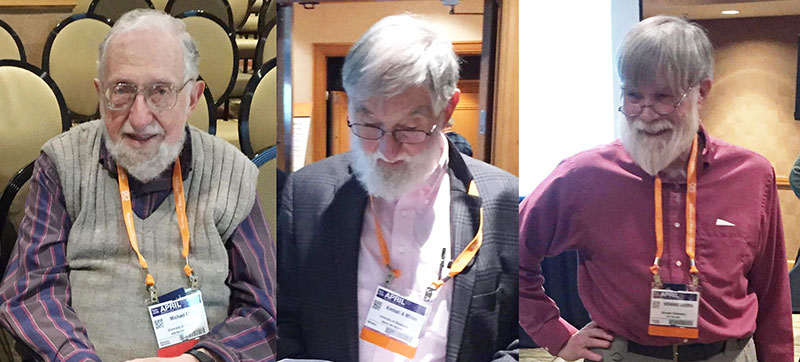“Remembering Julian Schwinger” (DPF co-sponsor)
By Donald Salisbury
Celebrating somewhat tardily the centennial birthdate of Julian Schwinger on February 12, 1918, roughly forty attendees were treated to personal reminiscences on one of the leading theoretical physicists of the twentieth century. Touching a theme that would be repeated by all three presenters, Michael Lieber, whose title was “Divergence”, was the first to recall the mesmerizing effect of Schwinger's lectures, characterizing them as like virtuoso violin performances. He asked Schwinger two years after having commenced his graduate studies at Harvard in 1957 if he would oversee a dissertation, and he agreed. Lieber experienced a couple of ``misstarts" involving first the 1955 renormalization approach of Bogoliubov and Shirkov, and then the Euclidean TCP theorem. After a respite in industry Lieber returned to Harvard and to Schwinger. The latter had famously exploited the link between Lorentz transformations and Euclidean rotations in his 1957 paper. He had of course also very early emphasized an almost universal role for Green functions, and the link between these themes formed a basis of Lieber's dissertation, completed in 1967, in which he constructed a Coulomb Green function by exploiting the O(4) symmetry of the non-relativistic hydrogen atom as analyzed by Schwinger in 1964. The result was an alternative derivation of Schwinger's original Lamb shift calculation. Not incidentally, this project also involved the use of variational techniques he had learned from his advisor, and it was Schwinger himself who recommended that since Larry Spruce at NYU was working on variational techniques related to scattering theory, he should join him there with a post-doctoral appointment.
The title of Kimball Milton’s talk was “A Remembrance of Julian Schwinger”. He was a PhD student of Schwinger at Harvard beginning in 1968. He received his doctorate in 1971, the year that Schwinger left Harvard for UCLA. Milton subsequently joined him at UCLA for the rest of the 1970's as his post-doctoral assistant. He has co-authored two textbooks based on Schwinger's lectures. In addition he co-wrote, with Jagdish Mehra, Climbing the Mountain. A Scientific Biography of Julian Schwinger. The authors interviewed several of Schwinger's friends and associates, and Milton recounted many of their recollections in his remarks. Particularly striking to me was a tale I had heard from my own teacher and friend at Syracuse University, Joe Weinberg. While a student at the City College of New York the fifteen year old Weinberg had found himself competing in the library with another youngster of the same age as they retrieved a mathematics book on real variables. Schwinger was the faster reader, but Weinberg was no slouch. They ended up as life-long friends, actually overlapping for a time with Oppenheimer at Berkeley before the war. It was soon after that Schwinger came to the attention of Rabi who arranged a transfer as an undergraduate to Columbia University. The stories of the gentle prodigy at both institutions are legion and Milton could not begin to cover them. But he did include the episode at CCNY when Schwinger stopped abruptly before the hurdle in the compulsory gym exam, lamenting that there was ``not enough time to solve the equations of motion", and there was also the failed chemistry course at Columbia.
Perhaps less known of Schwinger's myriad accomplishments is the paper he wrote at age 16 at City College in which he effectively introduced the field theoretic interaction representation. (This unpublished paper appears in a collection edited by Milton.). The central role of nuclear physics in his early career has also tended to be unappreciated. Seven papers written under Rabi's guidance constituted his dissertation at Columbia. Most noteworthy was his correct prediction that the deuteron possessed an electric dipole moment arising through a broader isospin interaction. Already during his prewar stay with Oppenheimer and his wartime appointment to the MIT Radiation Laboratory he developed insights into the renormalization program in quantum electrodynamics that would earn him a share of the 1965 Nobel prize in physics. His work with synchrotron radiation not only taught him the importance of Green functions, but also suggested to him that electromagnetic interactions could be interpreted as altering both the mass and the charge of accelerating particles.
Howard Georgi spoke on “Julian Schwinger at Harvard before June, `67 – remembered by a star-struck and frequently confused undergraduate”. As an undergraduate Georgi took Schwinger's course in source theory at Harvard in 1966. After graduation in 1967 he went on to obtain his Ph. D. from Yale in 1971 where his advisor was Charles Sommerfeld, another of Schwinger's 73 dissertation students. He returned to Harvard in 1971 after Schwinger had left for UCLA. Schwinger can rightly be identified as a grandfather of electroweak unification. In 1956 he introduced the notion of hypercharge, and in 1957 he alluded to a notion of electroweak unification - with a V-A interaction, two neutrinos, and a charged intermediate boson. These are building blocks of the eventual Glashow, Weinberg and Salam theory. Georgi modestly omitted mention of his own contributions, in particular with the Schwinger student Glashow. But he did stress Schwinger's early mastery of group theory and his suggestion, concomitant with Gell-Mann in 1957, that there exists a larger global symmetry group for which the known baryons formed a multiplet. The suggestion was that this symmetry be broken through interaction with the known mesons.

Michael Kiefer, Kimball Milton, and Howard Georgi
The articles in this issue represent the views of their authors and are not necessarily those of the Forum or APS.
